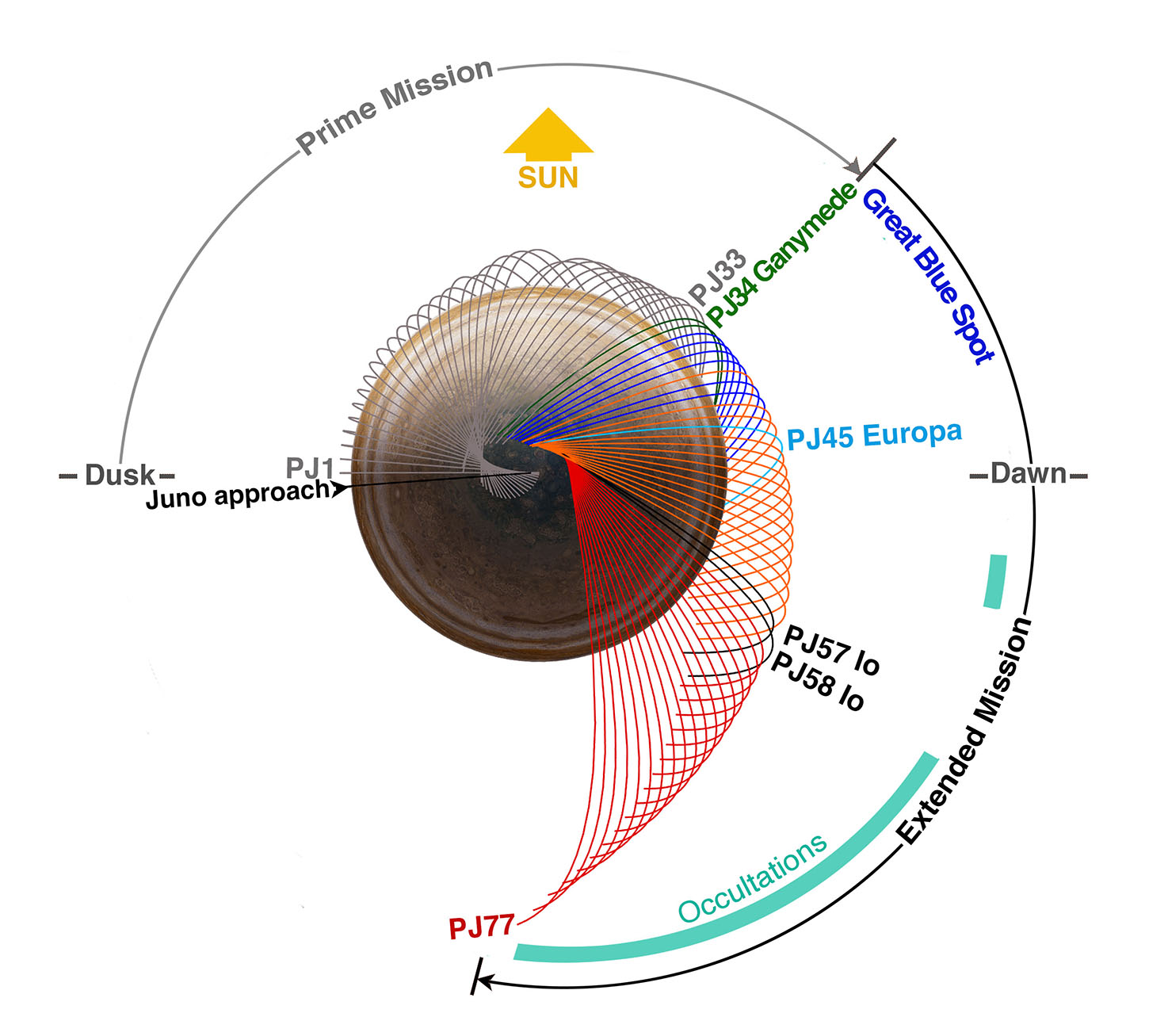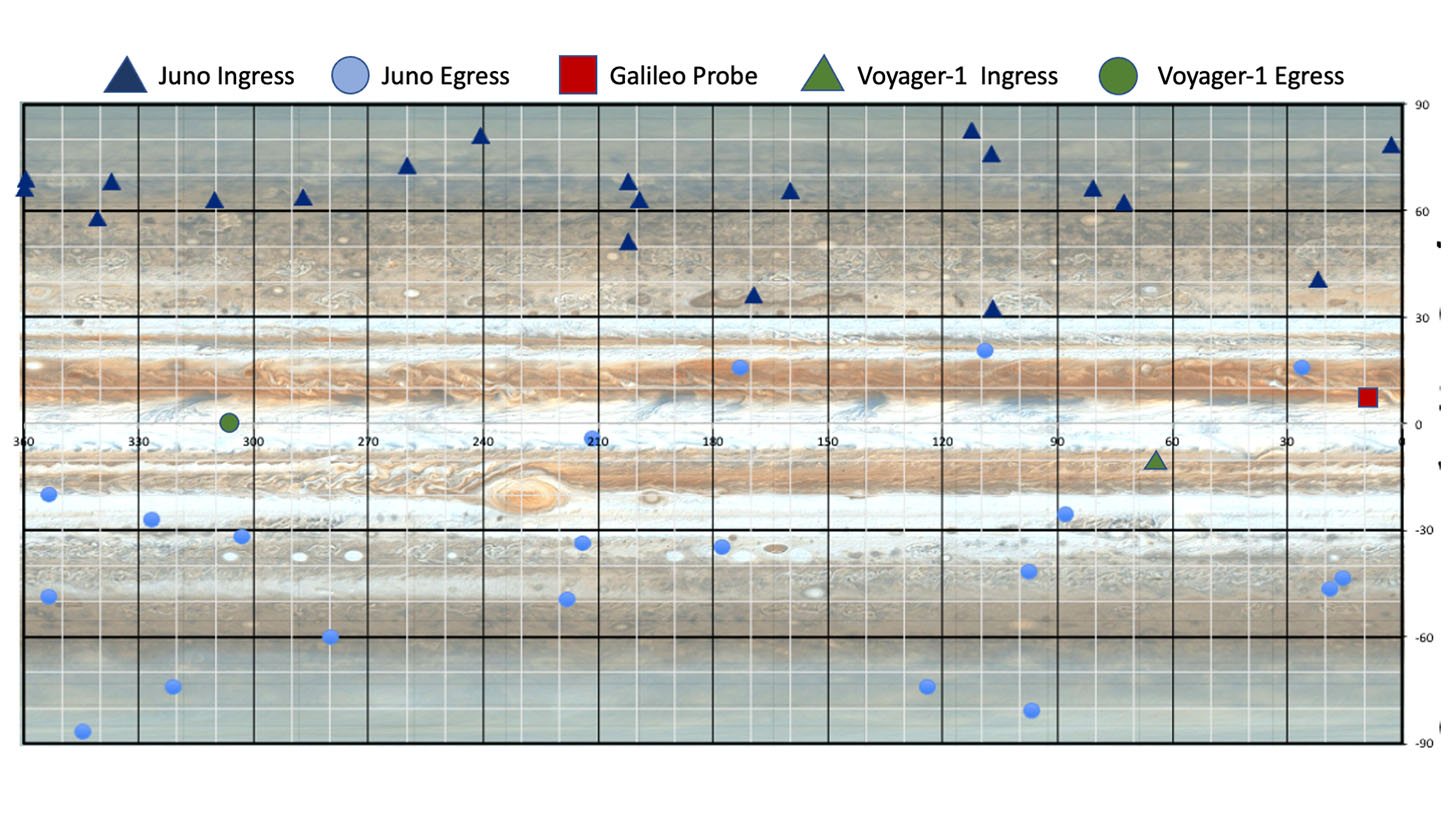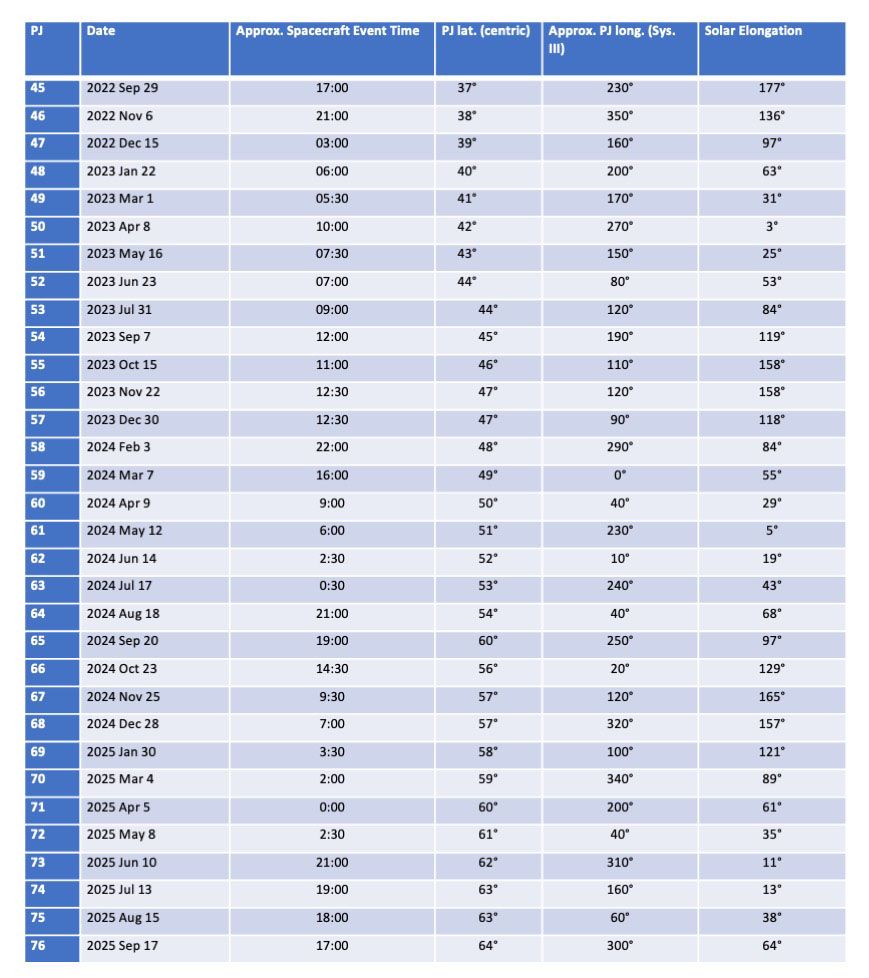The Juno Extended Mission: A Call for Continued Support from Amateur Observers
- 1Jet Propulsion Laboratory, California Institute of Technology, Pasadena, CA, United States of America (glenn.orton@jpl.nasa.gov)
- 2Planetary Science Institute, Tucson, AZ, USA
- 3Southwest Research Institue, San Antonio, TX, USA
- 4British Astronomical Association, London, UK
Introduction
The extended portion of NASA’s Juno mission began on 1 August 2021 and will continue through September 2025. The extended mission expands Juno’s science goals beyond those of the prime mission, as noted at the last EPSC (Orton et al. EPSC2021-58). Atmospheric studies will continue to be among the foremost of science goals and an area in which the world-wide community of Jupiter observers can provide significant contextual support. Juno’s remote-sensing observations will take advantage of the migration of its closest approaches (“perijoves” or PJs) toward increasingly northern latitudes. The observations should include close-ups of the circumpolar cyclones and semi-chaotic cyclones known as “folded filamentary regions”. A series of radio occultations will provide vertical profiles of electron density and the neutral-atmospheric temperature over several atmospheric regions. The mission will also map the variability of lightning on Jupiter’s night side.
Physical Details of the Mission
The sequence of orbits and key investigations of the primary and extended missions are shown in Figure 1. We note that on PJ34, the orbital period was reduced from 53 days to 43-44 days. It will be reduced shortly after this meeting on PJ45 to 38 days and again on PJ57 to ~33 days.

Figure 1. Progression of Juno orbits viewed from above Jupiter’s north pole with respect to local time of day. “PJ” designates a “perijove”, the closest approach to Jupiter on each numbered orbit. Following a Ganymede flyby on PJ34 (green orbit), the orbital period decreased from 53 days to 43-44 days (green + blue orbits). The “Great Blue Spot” (blue) orbits map an isolated patch of intense magnetic field. Following a close Europa flyby on PJ45 (aqua orbit), the period will decrease to ~38 days (orange orbits). Following close flybys of Io on PJ57 and PJ58 (black orbits) the period will decrease to ~33 days (red orbits). In reflected sunlight, Jupiter will mostly appear as a crescent at perijoves following PJ58.
Some characteristics of perijoves of the extended mission are shown in Table 1. We caution that while the day of year for the perijoves is reasonably fixed, the exact times may change by hours in either direction and the longitudes will change accordingly. Timing for later orbits up to PJ76, may be affected by currently unmodeled anomalies in satellite masses that could change dates and times.

Figure 2. Expected latitudes and longitudes to be measured by the 20 radio occultations of the Juno spacecraft between PJ52 and PJ77. Locations of ingress lie largely in the northern hemisphere - locations of egress in the southern hemisphere. Locations of the Galileo Probe and Voyager-1 radio occultations are also shown for reference.
Role of Amateur Astronomers
We’ve noted in the past at previous EPSC meetings how amateurs can contribute to the Juno mission via their collective world-wide 24/7 coverage of Jupiter. This applies also to the cadre of professional astronomers supporting the Juno mission and its reconnaissance of the Jupiter system over a broad spectral range. In the past, these have alerted observers to strong interactions between the Great Red Spot and smaller anticyclones (Sanchez-Lavega et al. 2021. J. Geophys. Res. 126, e006686) and the occurrence and evolution of prominent and unusual vortices, such as “Clyde’s spot” (Hueso et al. 2022. Icarus 380,114994). During the last apparition, observations were made with the NASA Infrared Telescope Facility (IRTF) that showed slow-moving bright patches in the Equatorial Zone (EZ) that were observed more continuously among the amateur community with 890-nm (“methane”) filters. We also identified an intense 5-µm spot detected using IRTF imaging that coincided with an unusually dark spot in amateur methane-filtered images. The continued tracking of outbreaks in the southern part of the North Equatorial Belt (NEB) also greatly informed the Juno team and supporting astronomers regarding the systematic longitudinal distribution of outbreaks and the range of atmospheric features they generate. A perijove-by-perijove summary of Juno-supporting observations – past, current and planned - is available at the following web site: https://www.missionjuno.swri.edu/planned-observations.
We want to emphasize that by PJ50, Juno’s perijoves will have migrated to a part of the planet that is not in sunlight. At that point and through the end of the mission, images from this community will be extremely useful to order to provide a context for several investigations. One of these will be chief on JunoCam’s agenda during this part of the mission: searches for lightning. But similar contextual information will be sought for measurements of thermal emission from the JIRAM instrument’s high-resolution maps of 5-µm emission, as well as the Microwave Radiometer (MWR) measurements of thermal emission from the deep atmosphere. Although the highest spatial resolution from these instruments will include high northern latitudes (see Table 1) that are not well resolved by small telescopes, measurements of mid-northern latitudes will continue to be made when JunoCam will not be able to provide a visual context.
Table 1. Current estimates for Juno extended mission perijoves PJ45-PJ53. Timing for orbits PJ54 onward may be affected by currently unmodeled anomalies in satellite masses that could change dates and times. Accordingly we list perijove times to the nearest half hour and longitudes to the nearest 10°. Orton et al. (EPSC2021-58) presented information for previous perijoves.

How to cite: Orton, G., Momary, T., Brueshaber, S., Hansen, C., Bolton, S., and Rogers, J.: The Juno Extended Mission: A Call for Continued Support from Amateur Observers, Europlanet Science Congress 2022, Granada, Spain, 18–23 Sep 2022, EPSC2022-769, https://doi.org/10.5194/epsc2022-769, 2022.

